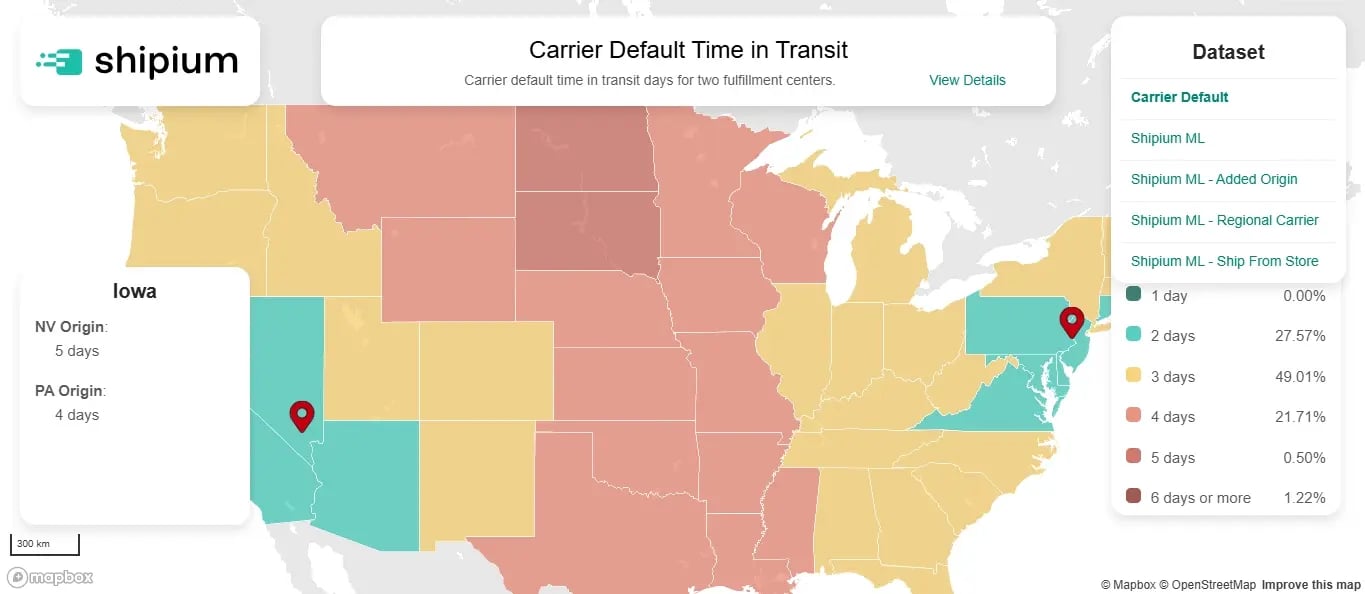Standard Shipping: The Definitive Guide

For enterprise logistics operators, offering free shipping or lower prices to customers involves multiple decisions: Where should we ship these items from? Which carrier should transport them? Most importantly, which shipping method is the most suitable for each circumstance?
According to the Green Mountain Benchmark report, customer demand for lower costs and pricing is a top supply chain challenge for retail companies. Adopting standard shipping methods can help retailers deal with this pressure. When used properly, this cost-effective option reduces per-parcel expenses and increases profit margins without affecting delivery reliability.
Let’s understand what standard ground shipping is and how enterprise businesses can implement this method to address customer needs and gain a competitive advantage.
Key highlights:
- Standard shipping in the U.S. is the most cost-effective delivery method, providing lower costs compared to expedited services.
- Offering a balance of affordable and fast shipping options helps enterprises meet consumer expectations, especially for non-urgent orders.
- Retailers that diversify their carrier mix can negotiate better rates for standard shipping methods, improve transit times, and mitigate capacity constraints caused by reliance on a single carrier.
- Shipium enables better domestic standard shipping performance. With AI-powered features, retail businesses optimize carrier selection, ensure accurate delivery estimates, and maximize cost savings.
What is standard shipping?
Standard shipping is the baseline, most economical shipping option available from a courier. The method is also known as budget, economy, ground, or regular shipping. Examples of standard options include UPS Ground, FedEx Ground, and USPS Ground Advantage.
When retailers select a standard service for domestic parcels, carriers transport their shipments in 1-7 business days. For international shipments, transport via air or sea may take 1-4 weeks.
Key standard shipping benefits
Offering standard ground shipping alongside other options helps diversify your delivery methods. It also optimizes your operation for cost, especially if you include multiple order fulfillment services to avoid shipping delays. Since this method has slower delivery times, it is best to offer it in conjunction with other options.
Standard shipping benefits include:
- Lower per-parcel cost: Economy services reduce your parcel spending since they are more affordable options, creating more profitable margins or even savings that you can pass on to customers or invest in other business areas.
- Greater negotiating leverage: Due to standard lower prices, you can send higher shipment volumes to a carrier, and be able to negotiate carrier rates for discounts.
- Extended fulfillment cutoff times: Without the pressure of same-day or two-day shipping, retailers can process more orders efficiently while maintaining service quality.
Learn how choosing an economy shipping method reduces costs for your operation.
How does standard shipping work?
Domestic standard shipping works primarily through ground transport, making it a slower but cheaper way to send packages. Expect longer delivery times compared to faster, more expensive options.
Here’s a breakdown of how to send shipments through standard methods:
- After a customer places an order, the order management system (OMS) processes it and provides an invoice for your client
- Then, it’s time to select the most optimal carrier and shipping method by evaluating cost, transit time, and service reliability
- The fulfillment system routes orders to the most strategic warehouse (normally those that are closer to customers) to minimize transit time
- Retailers use modern technology to generate shipment labels
- Then, it’s time to pack. Businesses can use any packaging that meets carrier requirements
- The assigned carrier picks up the shipment from the fulfillment center
- The customer order is transported in 1-7 business days
- The shipment is processed at the local delivery hub and prepared for last-mile delivery
- The package arrives at the customer’s location within the predicted timeframe
Standard ground shipping pricing varies based on parcel delivery distance, weight, and size. This pricing model is cost-effective for businesses and aligns with consumers’ preference for lower costs. According to The Future Shopper Report, the most important factor influencing purchase decision-making online is price.
Yet, because of the absence of delivery service-level agreements (SLAs) and general performance uncertainty, shippers don’t use economy options as frequently as they could. Legacy shipping technology or manual efforts simply don’t have the capabilities to send more volume to these standard services.
This is where Shipium comes in. We’re an end-to-end enterprise shipping platform that connects to all your existing systems to help you improve delivery efficiency.
Our ML-powered time-in-transit model creates estimated delivery dates (EDDs) for standard shipment options, enabling you to establish a dynamic SLA that’s backed by machine learning models.
 How long does standard shipping take?
How long does standard shipping take?Standard shipping timelines in the U.S. vary slightly by courier and individual shipment. But USPS, UPS, and FedEx all offer standard shipping times of five days or less.
Retailers can optimize speed by taking advantage of multi-carrier strategies, strategically placing fulfillment centers, and using predictive transit models like Shipium’s ML-powered time-in-transit model to improve delivery accuracy.
How long does standard international shipping take?
Most carrier companies offer international standard shipping options with delivery timelines ranging from 2-10 business days, depending on origin, destination, carrier network efficiency, and customs processes.
Actual transit times change based on external factors like:
- Customs clearance delays
- Duties, taxes, and issues with dangerous goods declarations
- Peak season congestion
- Macro-environmental changes related to weather or geopolitics
How much does standard shipping cost?
The cost of standard shipping in the U.S. depends on package weight, dimensions, destination, and carrier service. Major carriers like USPS, UPS, and FedEx offer economy ground services with competitive pricing, starting at $6 per parcel. Other regional companies may provide more cost-effective and specialized solutions for shorter distances.
For businesses shipping at scale, modern carrier selection and fulfillment optimization solutions like Shipium are key ways to minimize shipping costs and enhance standard shipping benefits.
How do other options compare to the standard shipping method?
You should always include a standard shipping method that caters to cost-sensitive customers’ needs, but that’s not enough. Enterprise ecommerce stores must present multiple shipping choices to accommodate varied client needs and make room for those who prefer to have their order arrive as fast as possible as well.
Let’s understand how standard shipping compares to other delivery methods:
Ground shipping vs. standard shipping
Standard shipping and ground shipping are mainly equivalent. But when shipping to Hawaii, Alaska, Puerto Rico, or international locations, standard shipment will involve air transport. In this case, logistics leaders should consider partnering with regional carriers for last-mile delivery since they can offer more specialized services to streamline the process.
International vs. standard shipping
When shipping to an international location, you also have the choice between express and standard shipping methods. Most carrier companies offer standard options with delivery timelines that vary between two and 10 business days. In case of customs delays, it can take even more time.
Express vs. standard shipping
Express and standard shipping serve different logistics needs. Express services are meant for urgent cargo or shipments that need to arrive quickly, often within 1-3 business days.
Also known as expedited shipping, this method has higher costs for enterprise retailers, requiring they use it strategically:
- For high-priority or time-sensitive orders, such as medical supplies or perishable goods
- To meet guaranteed delivery windows, especially for VIP customers or peak season shopping events
- To stay ahead of competitors, offering fast delivery on high-margin products to justify the added cost
- For customer recovery efforts, ensuring swift replacements for loss, damaged items, or ecommerce shipping delays
Note that, due to HAZMAT shipping compliance, you can only transport certain products using ground services. For example, USPS restricts the shipment of lithium batteries in electronic devices through air transportation.
Explore the best ecommerce shipping options.
Optimize standard ground shipping with Shipium
At Shipium, we’ve seen complex logistics strategies, like leveraging a multi-carrier network, work to reduce costs and speed up deliveries. To assist retailers that struggle with legacy systems that lack carrier flexibility, we offer automatic carrier selection, helping retailers access better prices and improve on-time delivery rates.
Using our modern tools, Shipium customers achieved a 95.4% on-time delivery rate during busy seasons despite capacity issues and compressed timelines. Also, 30.48% of all their shipments were delivered in four days or less, and 79.5% of those were shipped via a cheaper ground or economy method rather than a more expensive expedited option.
Request a demo to see how Shipium helps you make the most out of standard shipping.

Diagonal thinker who enjoys hard problems of any variety. Currently employee #5 and the first business hire at Shipium, a Seattle startup founded by Amazon and Zulily vets to help ecommerce companies modernize their supply chains. Previously was CMO at Datica where I helped healthcare developers use the cloud. Prior to that I came up through product and engineering roles. In total, 18 years of experience leading marketing, product, sales, design, operations, and engineering initiatives within cloud-based technology companies.


